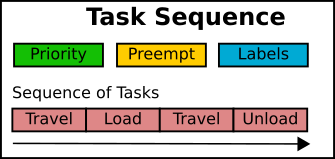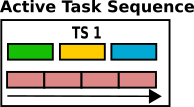How Task Executers Handle Tasks
Introduction to How Task Executers Handle Tasks
This topic will explain how task executers receive and execute task sequences. If you are using complex task logic in your simulation model, you might need to understand the concepts in this topic so that you are aware of how FlexSim handles task logic behind the scenes. This knowledge will help you understand and troubleshoot potential task logic problems---especially related to task dispatching logic and its related issues, such as task priorities and preemption.
Task Sequences and Tasks
Sometimes you might see the terms task and task sequence used interchangeably in this manual and in other FlexSim resources. While loose terminology usage isn't terribly problematic, there are very specific, and unique, technical meanings of the terms task and task sequence which are important to understand.
Definitions
Task - A single instruction or action that is performed by a task executer. Examples are load, unload, and travel.
Task Sequence - A collection of one or more tasks that are meant to be performed in sequence, generally uninterrupted, by a task executer. In addition to containing a sequence of tasks to perform, a task sequence holds values for priority and preemption, and can also store user-defined label values.

By default, a task executer will work on all the tasks in an entire task sequence from start to finish. Then, once the task executer has finished every task in the task sequence, it will finish/destroy the task sequence, and then look for a next task sequence to execute.
Task Sequences vs. Tasks: What This Means for Dispatching
Comprehending the difference between task sequences and tasks is important to understanding and controlling dispatching logic in FlexSim. If we think of a task as the most basic unit of work in FlexSim, a task sequence is the most basic unit of dispatching. Task sequences, not individual tasks, can be dispatched and moved around to different queues or lists. They can be prioritized and selected based on custom criteria, etc. Further, a task sequence enforces a specific ordering of task execution.
How Task Executers Handle Task Sequences
Task executers primarily keep track of two things:
- Active task sequence - The task sequence the task executer is currently working on.
- Task sequence queue - A queue of task sequences the task executer has been assigned to work on.

You can see a task executer's active task sequence in the tree by navigating to its "activetasksequence" variable.


During a simulation run, when a task executer receives a task sequence:
- The new task sequence will be added to the task executer's task sequence queue.
- If the task executer does not currently have an active task sequence, it will select a task sequence from its queue. Usually, a task executer will complete task sequences in the order they are received. In other words, it will do the tasks using FIFO logic (first in, first out). However, if you use task sequences with different priorities, the task executer will complete the task sequences in the order of their priority instead.
- The selected task sequence will become the active task sequence.
- The task executer will complete the tasks in the task sequence, generally uninterrupted, in the order they were added to the task sequence.
- After the active task sequence is complete, the task executer will select another task sequence from the queue and the process will repeat itself.
Dispatchers vs. Task Executers
A dispatcher object is similar to a task executer, except that it does not have an active task sequence. It only has a task sequence queue. This is what distinguishes the Dispatcher class from the TaskExecuter and its sub-classes.
Task Executer Events and Triggers
Task executers have a specific series of events and triggers that they go through while working on tasks. (See Key Concepts About Events for information about events and triggers.) A few of the important events are:
| Trigger | Explanation |
|---|---|
| On Start Task | Fires whenever the task executer begins performing a task |
| On Finish Task | Fires whenever the task executer finishes performing a task. |
| On Resource Available | Fires whenever the task executer has finished a task sequence, and is ready to execute another task sequence. |
| On Load | Fires when a task executer loads an item as part of a load task |
| On Unload | Fires when a task executer unloads an item as part of an unload task |
You can set custom animations or process flow activities to begin when any of these triggers are fired. You could also use triggers to design look-for-work systems in which task executers pull task sequences from a global list when their On Resource Available trigger fires. See Task Executer Concepts - Events for a more thorough explanation of the available events and triggers for task executers.